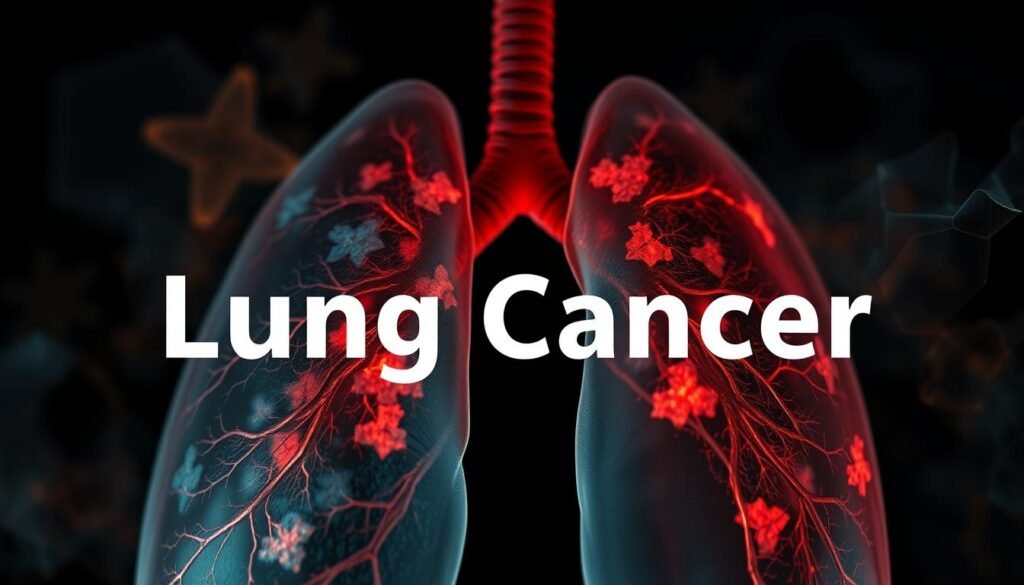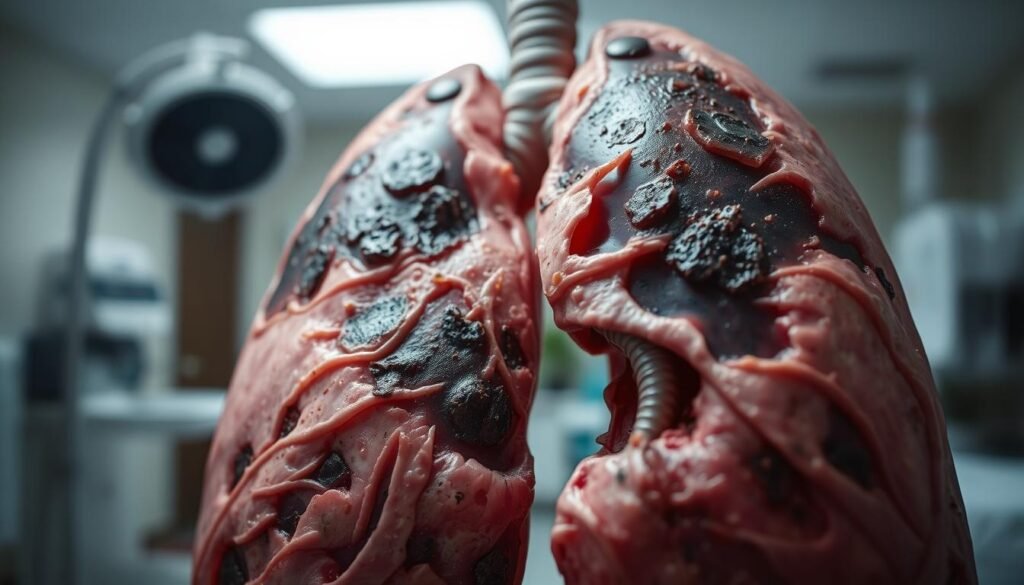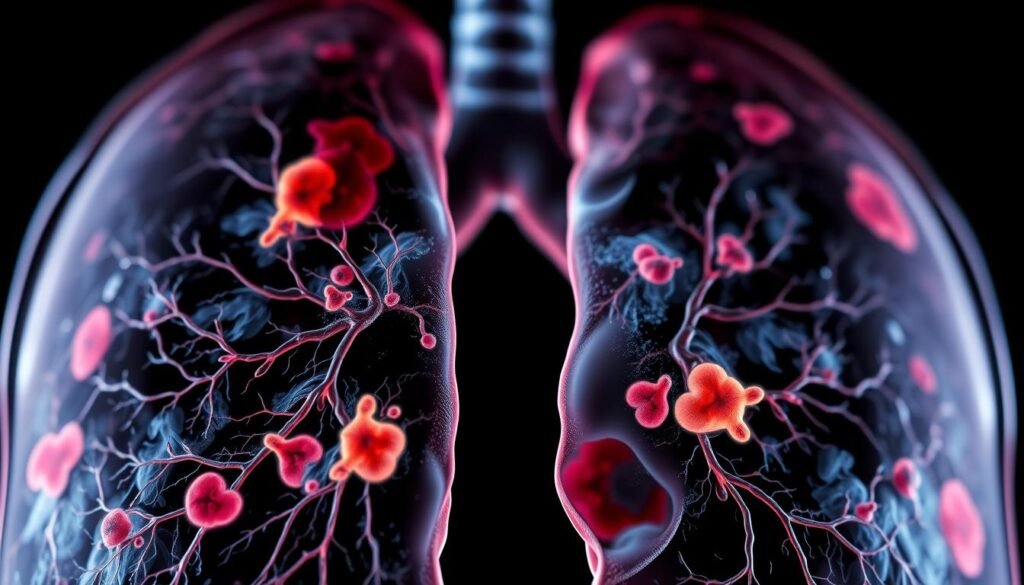Did you know the five-year survival rate for distant lung cancer is only 8%? This fact shows the tough situation for people with stage 5 lung cancer. Often called end-stage lung cancer, the disease spreads widely in the body at this stage. It points to a severe worsening of the disease.
What leads to this late-stage cancer? Usually, it’s long-term smoking, pollution, and harmful stuff like radon gas. Knowing about stage 5 lung cancer is crucial. Seeing real pictures can help us understand what patients and their families go through. These images give us a clear view of how serious this illness is.
Also, learning from real images of stage 5 lung stresses the importance of catching the disease early. As it gets worse, knowing more about it is key. This knowledge is vital for discussing treatments, support, and care for patients.
Key Takeaways
- The five-year relative survival rate for distant lung cancer is only 8%.
- Stage 5 lung cancer signifies extensive metastasis and severe disease progression.
- Common causes include prolonged smoking, pollution, and exposure to carcinogens.
- Visual representations provide critical insight into patient challenges.
- Understanding advanced lung cancer images can enhance awareness and support for patients and families.
Understanding Lung Cancer Stages
Knowing how far lung cancer has spread is key in deciding how to treat it. Stages of lung cancer, especially for non-small cell lung cancer (NSCLC), range from I to IV. Here, stage IV shows the cancer has spread far in the body.
Small-cell lung cancer (SCLC) is also getting a similar staging system. This helps everyone use the same terms. Before treatment, doctors figure out the stage clinically. Surgery lets them confirm this through pathologic staging.
The TNM system is common for NSCLC. It looks at tumor size (T), if lymph nodes are involved (N), and if there’s metastasis (M). This system guides doctors in treating the cancer.
Lung cancer staging starts at stage 0, where the tumor is still only in the airways. It goes up to stage IV, meaning the cancer has spread to distant places. There are more details in each stage about size and spread of the tumor.
| Stage | Description |
|---|---|
| Stage 0 | In situ tumor in the surface layers of lung cells. |
| Stage I | Tumors confined to one lung with no lymph node involvement. |
| Stage II | Tumors remain in the lung without any metastasis. |
| Stage III | Local spread within the chest without distant spread. |
| Stage IV | Advanced tumors that may have spread to distant organs. |
The Significance of Stage 5 Lung Cancer
Stage 5 lung cancer is a critical phase in the disease’s progression. It is often marked by the spread to multiple organs. Patients may face severe symptoms that change their life quality. At this point, treatment shifts from curing the disease to improving comfort. Caregivers and healthcare professionals need to offer support and discuss care goals.

Advocacy and education about this lung cancer stage are crucial. Metastatic lung cancer photos highlight the disease’s impact. They help loved ones understand what patients go through. Visual aids also aid in discussing treatment, care planning, and support, ensuring patients are not alone.
Learning from end-stage lung cancer illustrations helps grasp the severity of metastatic lung cancer. It makes clear the importance of recognizing physical signs early. Families are encouraged to seek medical help promptly, improving care. Early detection of symptoms leads to better management and conversations about patient wishes. Everyone gets the care they need.
| Stage of Lung Cancer | Common Symptoms | Treatment Focus |
|---|---|---|
| Stage 1 | Coughing | Surgery, Radiation |
| Stage 2 | Chest Pain | Chemo, Radiation |
| Stage 3 | Shortness of Breath | Combination Therapy |
| Stage 4 (Metastatic) | Fatigue, Weight Loss | Palliative Care |
| Stage 5 | Severe Symptoms, Decreased Functionality | Symptom Management |
Understanding stage 5’s significance shows the need to recognize symptoms early. It highlights the importance of communication with doctors. Using educational materials can improve patient outcomes. With the right care and support networks, families and patients can face challenges with dignity.
For more information on lung cancer stages, visit this resource. To learn about early lung cancer signs, visit this link. Knowing early signs helps get the necessary support and medical care.
Stage 5 Lung Cancer Real Images Revealed
Visuals are vital to grasp the severity of stage 5 lung cancer. Images show the drastic changes patients go through. These terminal lung cancer pictures can deeply move us, showing the disease’s toll on bodies and health.
Visual Impact of Terminal Lung Cancer Pictures
Looking at severe lung cancer visuals helps us understand its impact. We see important signs like:
- Weight loss due to less appetite and changes in metabolism.
- Respiratory distress, highlighting the breathing struggles as cancer grows.
- Other signs like changes in skin color and weakness.
These powerful advanced lung cancer images are educational and foster empathy. They remind us of the real people behind each diagnosis.
Insights from Advanced Lung Cancer Images
These visuals give valuable insights for healthcare talks. They make honest discussions about symptoms and daily issues easier. Insights from terminal lung cancer pictures lead to better care focused on patients.
For doctors, using these severe lung cancer visuals promotes empathy in care. Sharing these real-life advanced lung cancer images lets patients feel understood. They know they’re supported in their treatment journey.
Symptoms of Advanced Lung Cancer
Advanced lung cancer affects patients’ lives in many ways. It’s important to spot these signs early for better care. Knowing about late-stage lung cancer helps families and doctors meet patients’ needs.
Recognizing Late-Stage Lung Cancer Visuals
Late-stage lung cancer has certain signs we can see in images. These signs tell us the cancer is serious. By looking at these images, we can spot symptoms like:
- Persistent cough
- Chest pain
- Wheezing
- Shortness of breath
- Fatigue
These signs are red flags. To learn more about these symptoms, check out this resource.
Common Symptoms at Stage 5
Stage 5 symptoms are very serious. They need quick medical help. Symptoms include:
| Symptom | Description |
|---|---|
| Coughing up blood | This means the cancer might be growing. |
| Severe fatigue | This happens because the body is fighting the cancer. |
| Substantial weight loss | It’s when people lose weight without trying. |
Seeing severe cases helps us understand what patients go through. This makes giving comfort and managing pain so important.

Diagnosis and Staging of Lung Cancer
Lung cancer diagnosis starts with tests like chest X-rays, CT scans, and biopsies. These imaging tests show what’s going on inside the body. They let doctors see if there are tumors. The process of cancer staging is very important too. Knowing the stage helps pick the best treatment and guess how it will go.
The TNM system is a big part of staging cancer. It looks at tumor size and place (T), if lymph nodes are involved (N), and if it has spread (M). Non-small cell lung cancer (NSCLC) goes from stage 0 to IV. Stage 0 means cancer hasn’t spread outside the lung’s lining. Stage IV means it’s spread far. Small cell lung cancer is either limited or extensive, based on how much it has spread.
| Stage | NSCLC Description | SCLC Description |
|---|---|---|
| Stage 0 | Localized cancer, not beyond the lung lining. | N/A |
| Stage I | Tumor present, no lymph node involvement. | Limited stage, cancer in one lung. |
| Stage II | Spread to nearby lymph nodes. | Limited stage, may have local spread. |
| Stage III | Advanced local spread, significant lymph node involvement. | Extensive stage, cancer in both lungs or other organs. |
| Stage IV | Widespread metastasis to other organs. | Extensive stage, often irreversible. |
Before treatment, techniques like EBUS-TBNA and mediastinoscopy check if cancer has reached lymph nodes. Pathological staging after removing the cancer can also adjust the stage. This helps tailor the treatment better. For patients with returning lung cancer, restaging with imaging tests is crucial. It checks how the disease has progressed. These detailed checks help make treatment more precise. They might even help patients live longer.

Treatment Options for Advanced Lung Cancer
Patients with advanced lung cancer have many treatment options. These options aim to manage symptoms and improve life quality. Stage 5 lung cancer treatments include chemotherapy and radiation therapy tailored to each patient. These methods can offer significant relief.
Terminal lung cancer treatments focus on managing symptoms, not curing the disease. Palliative care is crucial, providing comfort and support. Combining palliative care with other treatments helps patients feel better and may extend their lives.
Understanding available treatments is important. This includes targeted therapies that attack specific cancer cell mutations. Immunotherapy is also promising, helping the immune system destroy cancer cells.
Talking with a multidisciplinary care team can help in making treatment decisions. Patients might also explore clinical trials for new therapies. These trials provide hope for those with late-stage cancer. More details about treatments are available at NCI’s non-small cell lung cancer treatment page.
| Treatment Option | Description | Purpose |
|---|---|---|
| Chemotherapy | Administered in cycles over weeks or months. | Target cancer cells; alleviate symptoms. |
| Radiation Therapy | May be used before or after surgery, or alone. | Relieve pain; reduce tumor size. |
| Immunotherapy | Boosts the body’s immune response against cancer. | Target and destroy cancer cells. |
| Palliative Care | Focuses on relief and quality of life improvement. | Symptom management; overall comfort. |
| Targeted Therapy | Attacks specific mutations in cancer cells. | More effective treatment with fewer side effects. |
Emotional Impact and Support for Patients
The journey for stage 5 lung cancer patients is emotionally complex. The value of emotional support is crucial here. These patients often struggle with the mental effects of their diagnosis. This makes it critical to focus on their mental health needs.
Addressing Mental Health Challenges
Anxiety and depression are not uncommon during cancer treatment. Anxiety symptoms can include a fast heartbeat, headaches, or stomach issues. Depression may bring sadness, numbness, or strong feelings of despair. Spotting these symptoms early is key for stage 5 lung cancer care.
- Common anxiety symptoms:
- Rapid heartbeat
- Muscle pains
- Changes in eating habits
- Sleep disturbances
- Common depression symptoms:
- Feelings of sadness
- Difficulty concentrating
- Fatigue
- Unexplained changes in weight
It’s crucial for those struggling to find support. This may be from friends, family, or counselors in emotional support. Many cancer survivors today credit their well-being to strong support networks. Joining support groups or counseling can help those feeling alone.
Patients often feel overwhelmed by the emotional load of cancer. Counseling offers them a safe place to share their fears. It helps them build strength and improve their emotional well-being.
Being well-informed about one’s condition helps emotionally. Knowing about symptoms can reduce fear over new aches. Useful information on lung cancer signs and when to seek help is available here.
| Symptom | Causes of Concern |
|---|---|
| Anxiety | May lead to heightened physical symptoms and exacerbate patient concerns. |
| Depression | Can result in disengagement from treatment and decrease quality of life. |
| Isolation | Feelings of loneliness can intensify, impacting overall emotional health. |
Mental health is crucial in stage 5 lung cancer care. Strong support networks and mental wellness can help patients face their journey with resilience and hope.
Life Expectancy and Survival Rates
The outlook for people with stage 5 lung cancer is not very hopeful. Survival rates drop a lot compared to earlier stages. Only about 8% of those with non-small cell lung cancer live past five years. For small cell lung cancer, this number is even lower at 3%. Knowing about life expectancy at this stage is key for patients and families making tough treatment decisions.
Factors Affecting Survival in Stage 5 Lung Cancer
Many factors play a part in the survival rates of stage 5 lung cancer. The patient’s health, how they respond to treatment, and the support they get matter a lot. Sadly, 25-30% of people with advanced non-small cell lung cancer have a life expectancy of less than three months. But, new treatments offer some hope, giving today’s patients better chances than those five years ago.
Race and where people come from also affect survival in lung cancer. Studies show that Black individuals have higher death rates from lung cancer. Survival rates vary due to many factors, including the type of lung cancer someone has. Talking with healthcare providers about personal situations is crucial to understanding what to expect.